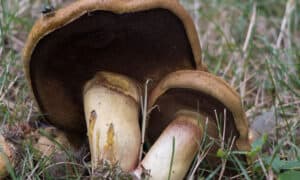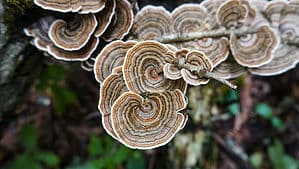Mushrooms as an organism often defy categorization attempts. They’re not exactly plants — in fact, mushrooms share more DNA with humans than they do with plants! These weird little wonders also span the gamut between delicious and deadly. Most mushrooms thrive in environments with plenty of organic matter, damp soil, and shade, but many yellow mushrooms seem to love these conditions. You can find yellow specimens in yards, wooded areas, and even potted plants.
Mushroom foragers adore yellow mushrooms for their bright colors. However, while some yellow mushrooms are delicious and highly sought after, some are very poisonous. Unless a wild mushroom has been identified by an expert, take great caution before picking or eating it. Also, if you go foraging yourself for the high-priced yellow mushrooms, remember to practice good foraging habits. Don’t take everything you find and try and adhere by the Leave No Trace principles. Now let’s discover the 17 types of yellow mushrooms.
1. Golden Chanterelle Mushroom
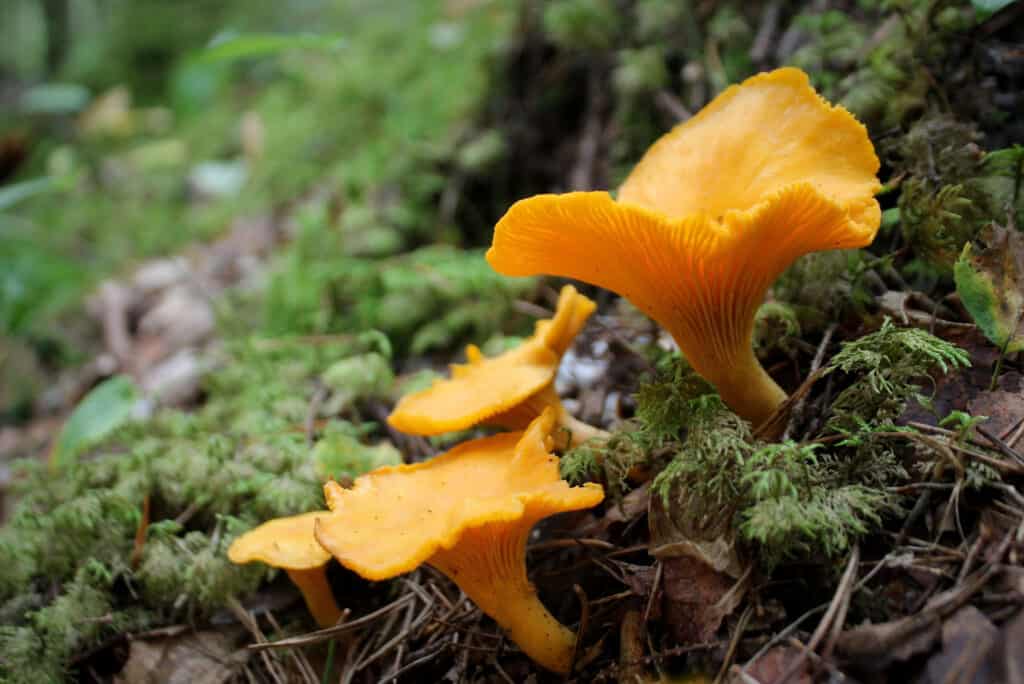
The golden color of chanterelles is mimicked by other non-edible mushroom species.
©Paula Savelius/Shutterstock.com
Cantharellus cibarius
Beautifully yellow’ish and vibrant, golden chanterelles range from pale yellow to a dark yellow-orange. These tasty fungi appear in lawns and forests and seem to prefer growing near trees like oak, beech, and birch. While Cantharellus cibarius only grows in Europe, there are many other species of golden chanterelles that grow around the world. They appear from late summer to late fall depending on the climate. Golden chanterelles feature thin stems and wavy, irregular caps that flare out and sometimes curl up. Their false gills are prominent and normally are slightly lighter in color than the top of the cap. The flesh is white and will peel apart like string cheese. Sometimes, some species of chanterelles may show red dots on the cap where the mushroom has been handled or damaged.
Golden chanterelles smell like apricots to some people! They can grow up to three inches tall or even larger, with caps up to four inches wide. Foragers love the delicious chanterelle, both for eating and selling. Make sure to clean these fungi well, as their bases and stems hold onto dirt. Also, beware look-alikes. To the untrained eye the jack-o-lantern mushroom can closely resemble the golden chanterelle but beware as it is poisonous. There may be other mushrooms that could fool the untrained eye as well.
2. Jack-o-Lantern Mushroom
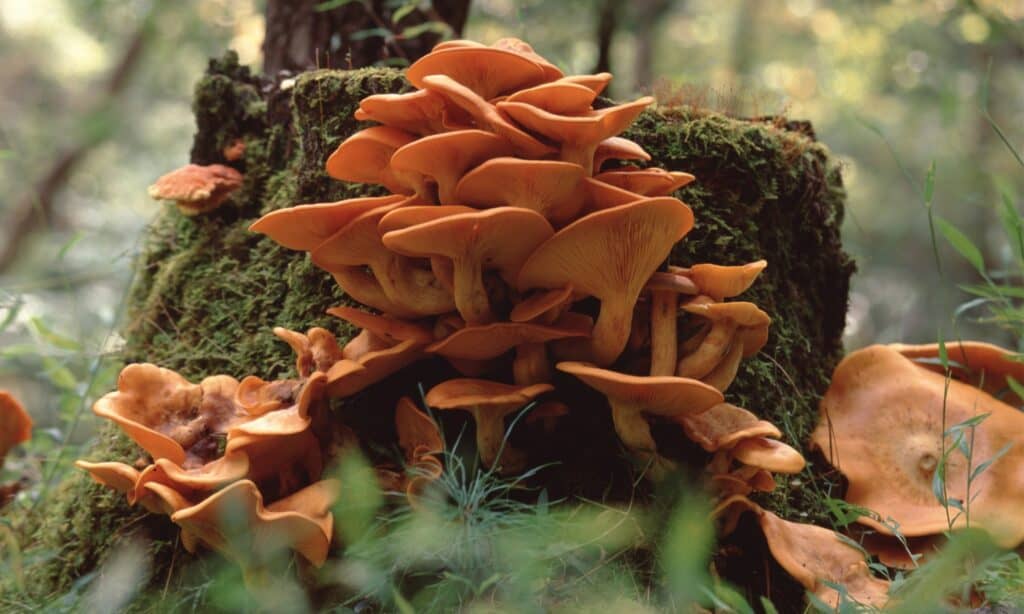
There are different species of Jack-o’lantern mushrooms all over the world that can resemble chanterelles.
©iStock.com/Weber
Omphalotus illudens
A poisonous chanterelle look-alike, jack-o-lantern mushrooms grow in large clusters on rotting stumps, underground roots, or the bases of hardwood trees. This specific orange-yellow mushrooms grows in the eastern U.S. and is named for their mild bioluminescent properties. Their gills emit a faint and spooky green-ish light in dim to dark lighting while young and fresh.
Jack-o-lantern mushrooms initially grow in clusters as multiple separate fruiting bodies that eventually grow to look somewhat like golden chanterelles. The poisonous imposter’s caps eventually become irregular and funnel-shaped, reaching up to eight inches across. The jack-o-lantern’s clustering growth pattern is one main way to distinguish them from golden chanterelles. Jack’s having real gills instead of the false gills is another way to help tell the difference.
3. Mud Puppy Mushroom
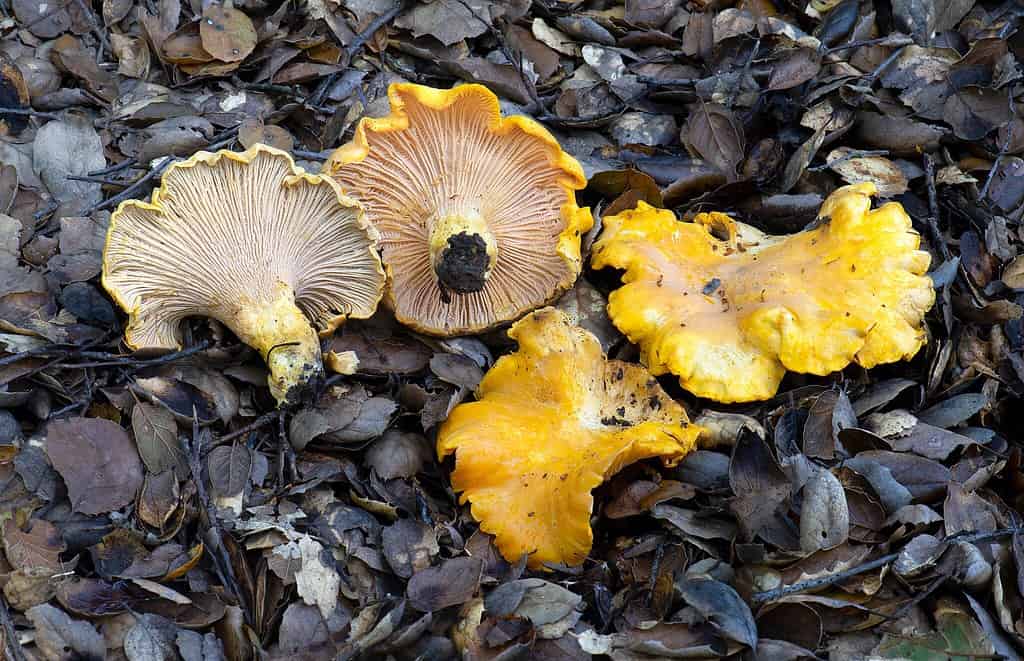
A member of the chanterelles, mud puppy mushrooms thrive in wet, muddy conditions.
©Alan Rockefeller / CC BY-SA 4.0 – License
Cantharellus californicus
As its scientific name hints, these mushrooms are native to California, with their typical range from the Bay Area to Los Angeles. Mud puppy mushrooms are another type of chanterelle and are sometimes called oak chanterelles due to their preference for sprouting near oak trees. It should be noted that many different chanterelles can be associated with oaks though. They feature creamy yellow to bright yellow coloring and share many of their shape characteristics with other golden chanterelles. Their irregular caps and lighter false gills prefer a lot of moisture, so they prefer to grow near streams and often push up through muddy debris, hence its name.
Mud puppy mushrooms grow slightly larger than other chanterelle species. Their caps can reach eight inches across, though their stems remain short. This combination results in a short-and-squat stature that makes them somewhat easier to identify.
4. Yellow Patches Mushroom
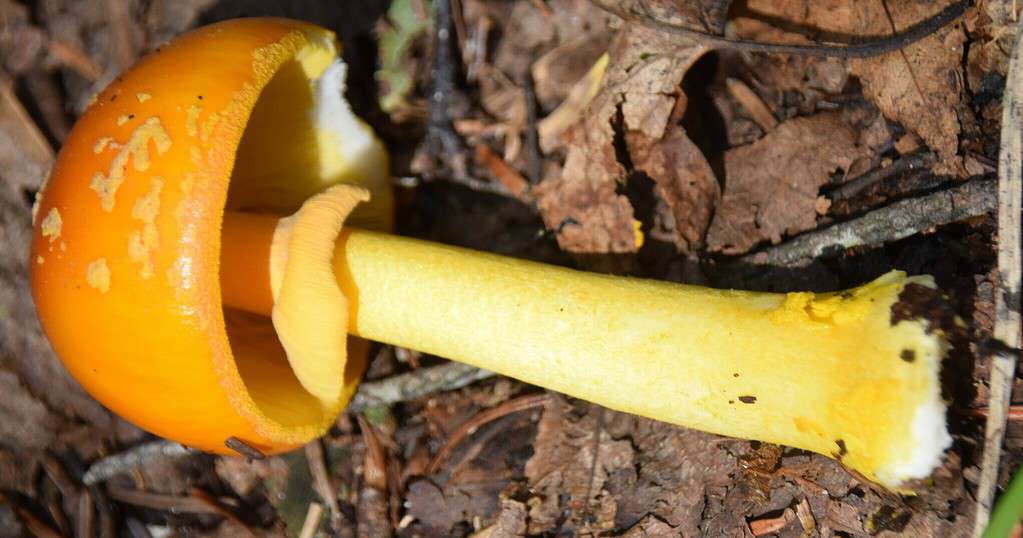
Yellow patches mushrooms have beautiful yellow colors all over them.
©Pierre Cartier / CC0 – License
Amanita flavoconia
The yellow patches mushroom looks like the toadstool of your dreams. A rounded, yellow-orange cap that’s either smooth or has small warts on its surface and a tall, pale stem makes for an iconic mental picture. Their sticky caps grow to about four inches wide on a stem up to four inches tall. Some sources may suggest that this mushroom is highly poisonous, possibly even fatal if ingested, but that just isn’t the case. That said, the genus Amanita does contain some of the more deadly mushrooms out there, so we do not advise consumption. Yellow patches commonly live in the central and eastern parts of North America, appearing throughout the summer and fall in naturalized areas with lots of organic matter.
5. Wood Hedgehog Mushroom
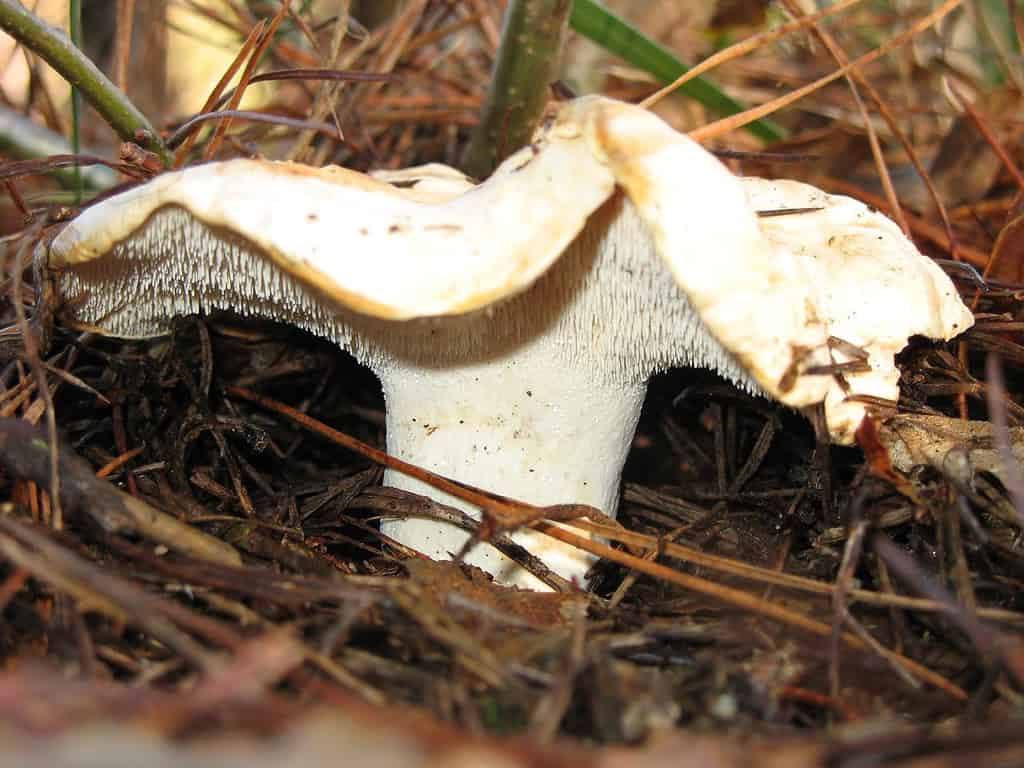
The teeth on the underside of
hedgehog
caps set this mushroom apart from many other fungi.
©Norte / CC BY-SA 2.0 – License
Hydnum repandum
This mushroom may look more tan or buff than yellow, but it can still have a yellow tinge to it. Rather than the traditional gills that many mushrooms have, wood hedgehogs feature pale teeth on the underside of their caps. Wood hedgehog caps are thick and irregularly shaped, with a wavy edge and pale yellow-to-tan coloring. They can grow to reach over six inches in diameter, while their stems may reach up to four inches tall.
Some current studies debate where all the specific species H. repandum may be found, but there are similar species that grow in many areas of the world. It is sold alongside chanterelles for its meaty texture and mildly nutty and peppery flavor. However, the Red Data Lists of Germany, Belgium, and the Netherlands list the wood hedgehog as vulnerable. Other species of the Hydnum genus grow in North America and have a variety of different characteristics that can help differentiate them.
6. Yellow Fieldcap Mushroom

Short-lived and eye-catching, yellow fieldcap mushrooms can pop up anywhere.
©Dr. Hans-Günter Wagner / CC BY-SA 2.0 – License
Bolbitius titubans
Yellow fieldcap mushrooms typically appear wherever organic matter is plentiful. Their little yellow heads pop up in clusters of bell-shaped caps with thin, white stems. As they age, the gills of this mushroom turn from yellow-white to brown and the cap expands until it flattens out. However, their life cycle moves very fast — these mushrooms are quite shortest-lived compared to many others.
These small yellow mushrooms aren’t known to be edible. They grow to reach about five inches tall with caps approximately two inches wide. Though some people may think they are unsightly in your lawn, they’re a sign of plentiful nutrients in your soil.
7. Golden Oyster Mushroom
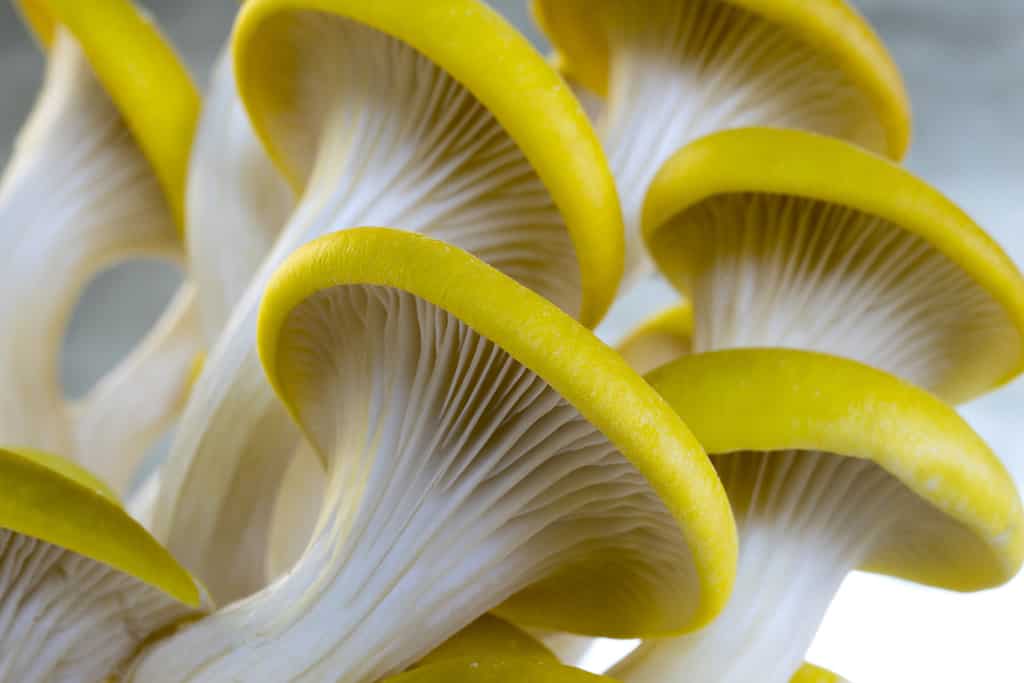
Golden oyster mushrooms exhibit a striking yellow color.
©vivid phantasy/Shutterstock.com
Pleurotus citrinopileatus
Oyster mushrooms are popular for cooking, and golden oysters are no exception. With their mild, delicate flavor and velvety texture, they’re popular choices among chefs and sought after by foragers. These mushrooms are native to eastern Russia, northern China, and Japan, and are one of the most popular wild mushrooms eaten in Russia. Golden oysters were introduced to North America as a commercial product and now the semi-invasive fungi can be found by foragers in several states in the Midwest and East Coast and the list is growing. From Minnesota down to Missouri and all the way east out to Maryland, New York and further north.
All oyster mushrooms grow on decaying wood. Golden oysters seem to prefer growing on hardwoods, like elms, and mature in large clusters. Their circular yellow caps develop their signature funnel divot. Their caps can reach three inches across with curved or bent white stems. These stems have gills that run down them, this term is called decurrent.
8. Golden Waxcap Mushroom
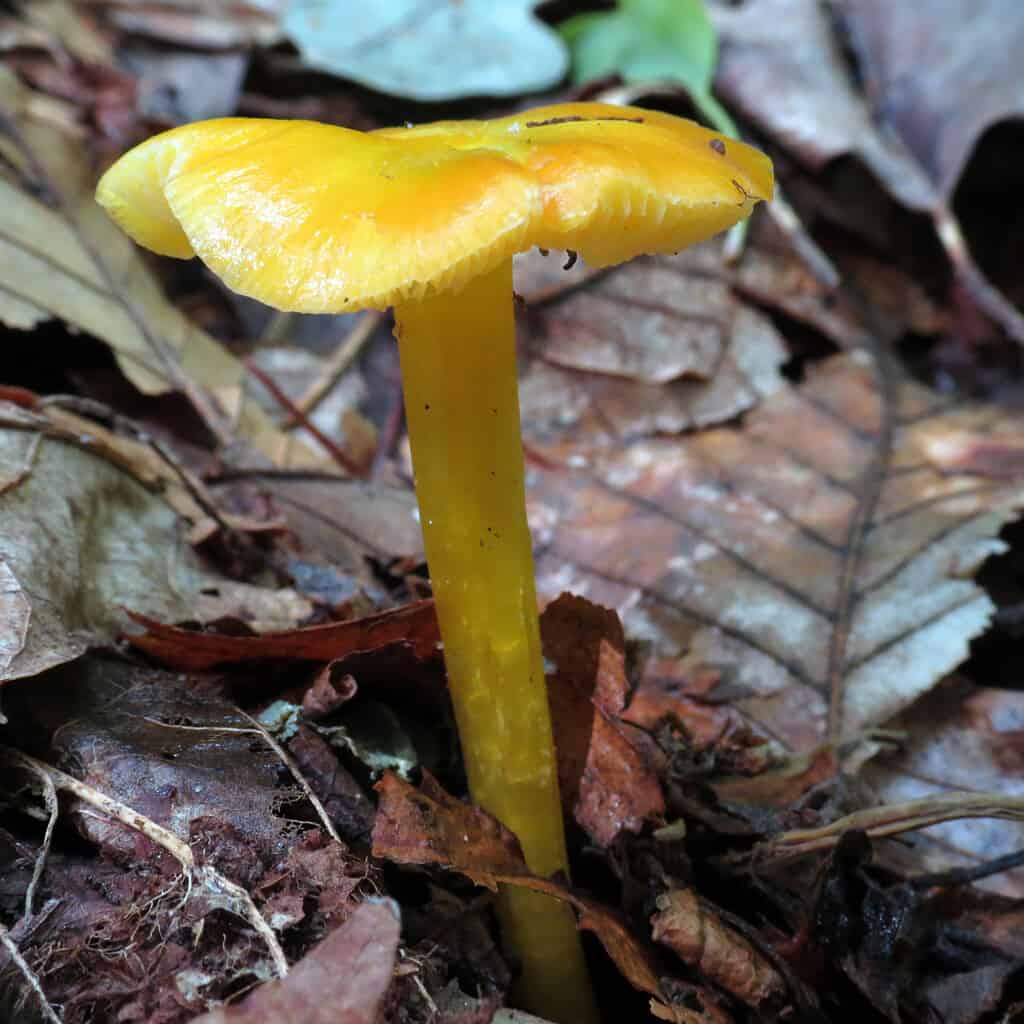
The bright yellow coloring of golden waxcaps makes them especially eye-catching.
©Katja Schulz / CC BY 2.0 – License
Hygrocybe flavescens
Golden waxcaps feature a bright yellow stem and cap that stands out against a green lawn or brown woodland. Their caps are sticky to the touch when young and go from a traditional convex shape to almost flat as they mature. Golden waxcaps can grow up to four inches tall with a nearly 2-inch cap. Although the exact environmental roll of these mushrooms isn’t fully understood as of yet. They do seem to prefer hardwoods and conifers but grow under different trees in different regions. The golden waxcaps seen on the west coast of North America like to grow under coastal redwoods, while on the east coast they choose beech trees most often.
9. Golden Ear Mushroom
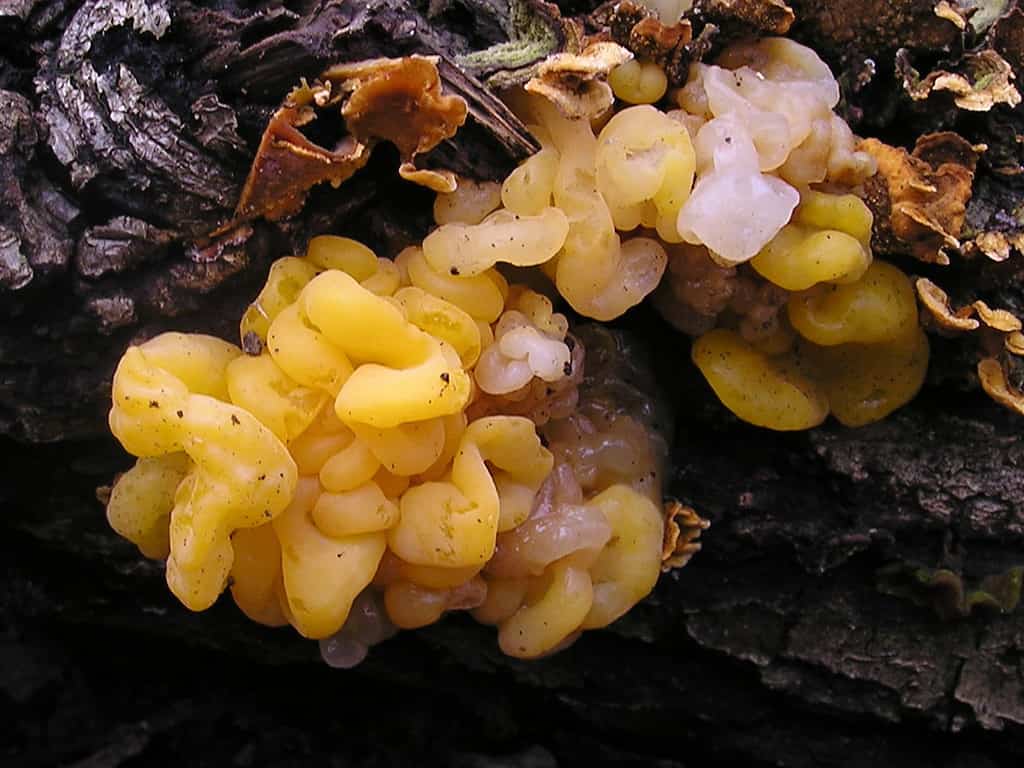
The unique structure of golden ear mushrooms appears slimy when wet.
©Strobilomyces / CC BY-SA 3.0 – License
Naematelia aurantia
Unlike many other species of mushroom, golden ears are considered true parasites. This mushroom doesn’t consume dead organic matter, but instead grows by eating other types of fungus already infesting the wood of a broadleaf tree. Golden ear mushrooms are bright yellow and can look gelatinous and shiny when wet and fully moisturized. The folds of this mushroom’s fruiting body grow in convoluted clusters that resemble ears if you squint.
Some experts call the golden ear “the jelly fungi of the Pacific Northwest,” due to the mushroom’s preference for coastal climates. However, specimens have been recorded in South America, Europe, and northern Asia. Clusters of golden ear mushrooms can grow to six inches across with no discernable stems. Golden ears are edible if cooked first, but don’t have much flavor.
10. Witch’s Butter Mushroom
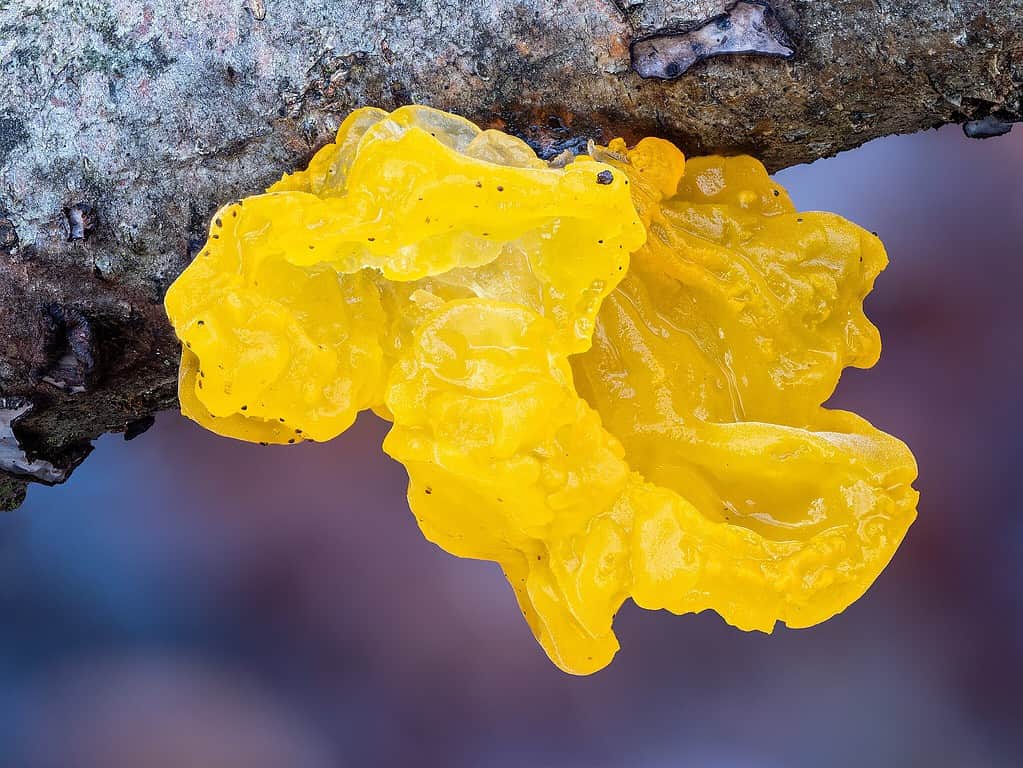
A true parasite, witch’s butter only appears in wood already infested with a different fungus.
©Reinhold Möller / CC BY-SA 4.0 – License
Tremella mesenterica
Witch’s butter is not closely related to golden ear mushrooms, even though they can look similar. As far as looks go, their main difference being the thinner, more elongated lobes on witch’s butter specimens. Another main difference is the type of fungus each eats. The Stereum that golden ear is parasitic on is much easier to see than the Peniphora crust fungus that witch’s butter is a parasite to. This mushroom is bright yellow with a jelly-like translucence. It grows in irregular shapes, usually on dead branches of hardwood trees still attached to the main trunk.
Witch’s butter mushrooms can grow to reach three inches in small clusters of lobes. This mushroom grows throughout North America and Europe and usually appears in the spring. Like golden ear mushrooms, witch’s butter is edible if cooked, but without any defining flavor.
11. Flowerpot Parasol Mushroom
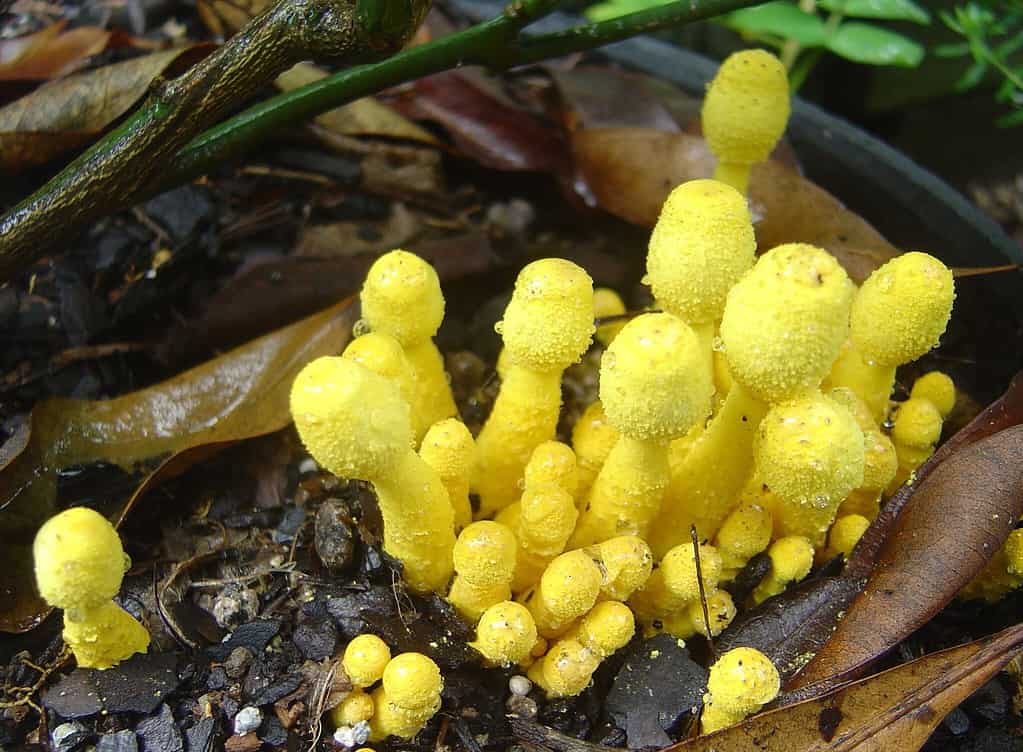
Gardens in tropical and warm climates — or humid greenhouses — may find these bright yellow mushrooms in their soil.
©Rae Allen / CC BY 2.0 – License
Leucocoprinus birnbaumii
These bright yellow buds frequently spook plant owners by showing up in potted plants. Flowerpot parasols are a stark contrast to the dirt they sprout from with sulfur- or lemon-yellow stalks and caps. These are mildly toxic to humans and canines, but ultimately harmless to the potted plant.
The flowerpot parasol mushrooms smell exactly like you’d expect a mushroom to smell. Just under four inches tall, their caps can grow to about three inches wide. These mushrooms prefer warm, moist conditions, which makes them a frequent — if uninvited— guest in greenhouses.
12. Golden Spindle Mushroom
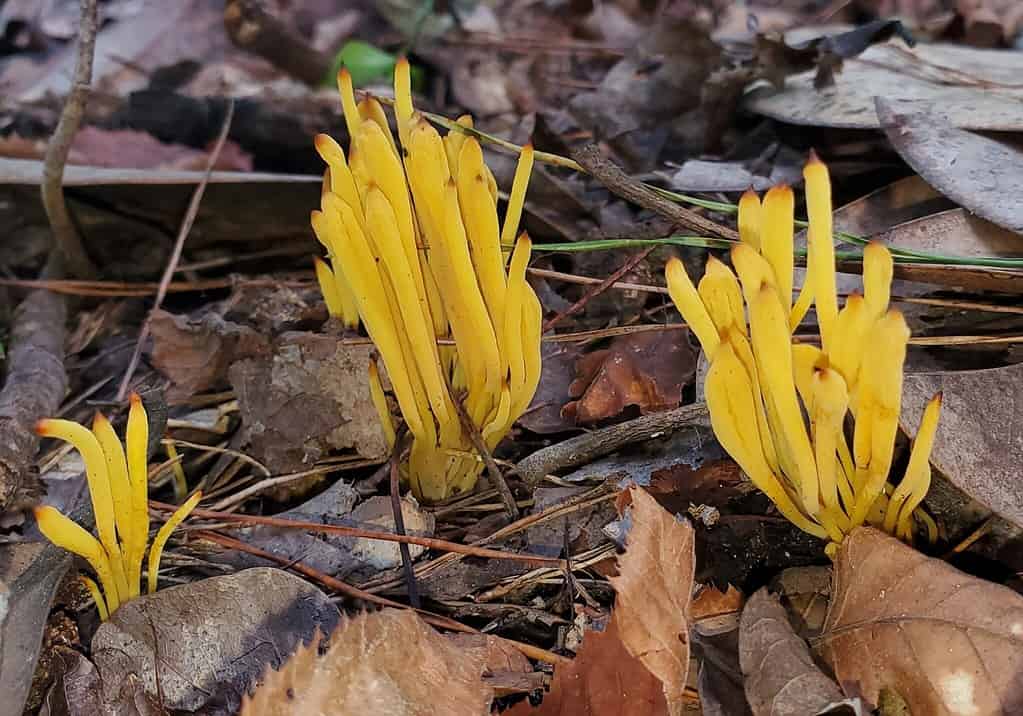
These odd looking mushrooms live up to the “spindle” part of their name.
©Laura Gaudette / CC BY 4.0 – License
Clavulinopsis fusiformis
This mushroom looks more like it belongs at the bottom of the ocean. Golden spindles look tall and thin, like pencils, with a golden-yellow hue that’s easily spotted. As they mature, the spindles become hollow and brittle. These clusters commonly grow the northern half of North America. Though different sources debate the edibility of golden spindles, they are not known to be toxic.
13. Sulfur Tuft Mushroom

Small and toxic, sulfur tuft mushrooms grow prolifically in woodland settings.
©Bernard Spragg. NZ / PDM 1.0 – License
Hypholoma fasciculare
These small mushrooms feature a smooth, convex cap that changes from sulfur-yellow to orange-brown in the center. Sulfur tufts remain small, rarely growing caps larger than two inches and stems taller than three inches. They grow in clusters on rotting stumps or roots of broadleaf trees throughout woodland areas in northern Europe and North America.
Sulfur tuft mushrooms glow faintly from their gills under some UV lighting. In fact, it’s the gills of this mushroom help distinguish it as a poisonous species. Some other species in the genus Hypholoma genus are known edibles, but the sulfur tuft’s green gills set them apart. Scientists attribute their toxicity to the fasciculol steroids.
14. Chicken Fat Mushroom
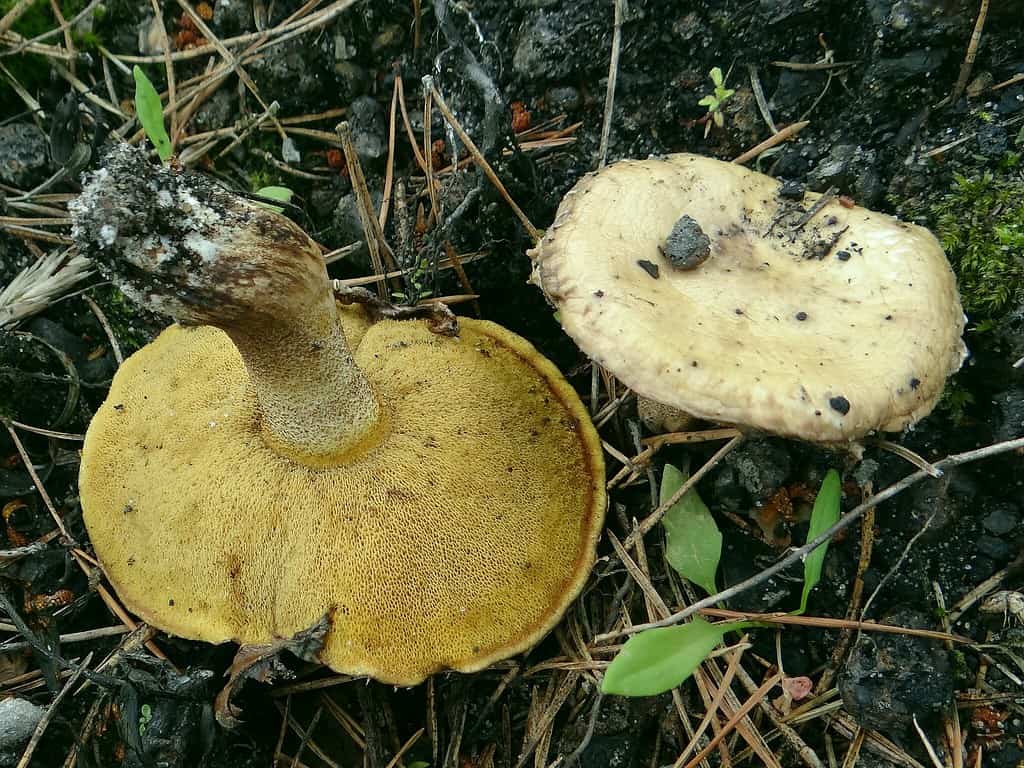
The porous structure of the chicken fat mushroom’s cap is usually trimmed before using it in culinary applications.
©Jerzy Opiola / CC BY-SA 4.0 – License
Suillus americanus
So named for its slimy cap and yellow coloration, chicken fat mushrooms grow in partnership with eastern white pines. The porous fertile surface underneath lets you know that it is a bolete. These mushrooms also exhibit staining that can turn to red or reddish-brown scales on their convex caps.
Chicken fat mushrooms primarily grow in eastern parts of North America, as well as Eastern Europe and China. They can measure up to four inches across and three inches tall. Though their flavor is hit-or-miss for most, these mushrooms are edible. Some describe them as similar to organ meats in flavor, while their sliminess evokes okra.
15. Chicken of the Woods Mushroom
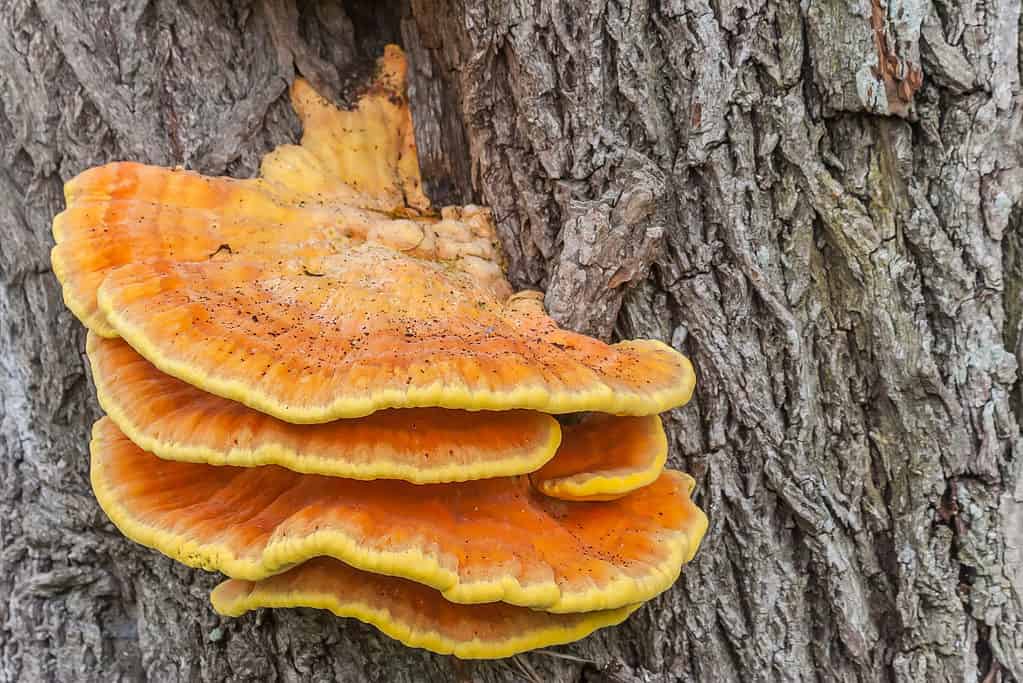
Chicken of the woods is one of the mushrooms that grows from the tree directly rather than on the ground.
©Marc Venema/Shutterstock.com
Laetiporus sulphureus
Unique and striking, chicken of the woods’ bright yellow-orange shelf-like fruiting bodies stand out easily in the woods. Some species like this one have a yellow pore surface underneath, while other species may have a white pore surface. These mushrooms grow in clusters that seem to stack on top of each other. This particular species is common in Europe and parts of the U.S. east of the Rocky Mountains. Laetiporus sulphureus can be featured in a great many vegetarian and vegan recipes. Their dense and succulent texture mimics the texture of meat in many ways, and some describe the mushroom’s flavor to chicken.
Chicken of the woods should always be cooked before eating and only the young, fresh specimens should be harvested. Older fruiting bodies lose their vibrancy and become dry, brittle, and tasteless. They are also more likely to lead to gastric issues. Each shelf of these mushrooms can grow up to nearly a foot across and an inch thick. Laetiporus sulphureus likes to grow on dead hardwood trees.
16. Yellow American Blusher Mushroom

The cap of yellow American blushers flatten out as the mushroom ages.
©Erlon (Herbert Baker) at Mushroom Observer / CC BY-SA 3.0 – License
Amanita flavorubens
The yellow American blusher ranges from lemon-yellow to a more brassy-yellow. When this mushroom first appears, their cap looks almost conical. However, as they mature, their cap flares out until flat or concave. Yellow American blushers prefer to grow in hardwood forests, especially near oak trees. They grow primarily in the eastern region of North America. However, scientists have recorded a completely separate western population present in southeastern Arizona and central Mexico.
Some people say these mushrooms smell interestingly of clean laundry. Their caps measure between one and four inches in diameter and sit atop a thick stem up to six inches tall. As a member of the Amanita genus, the yellow American blusher’s edibility is cautioned against. This genus is home to many lethal members, but also some tasty edibles. Perhaps it’s best to play it safe with this one, at least until you become an expert yourself.
17. Yellow Pholiota Mushroom
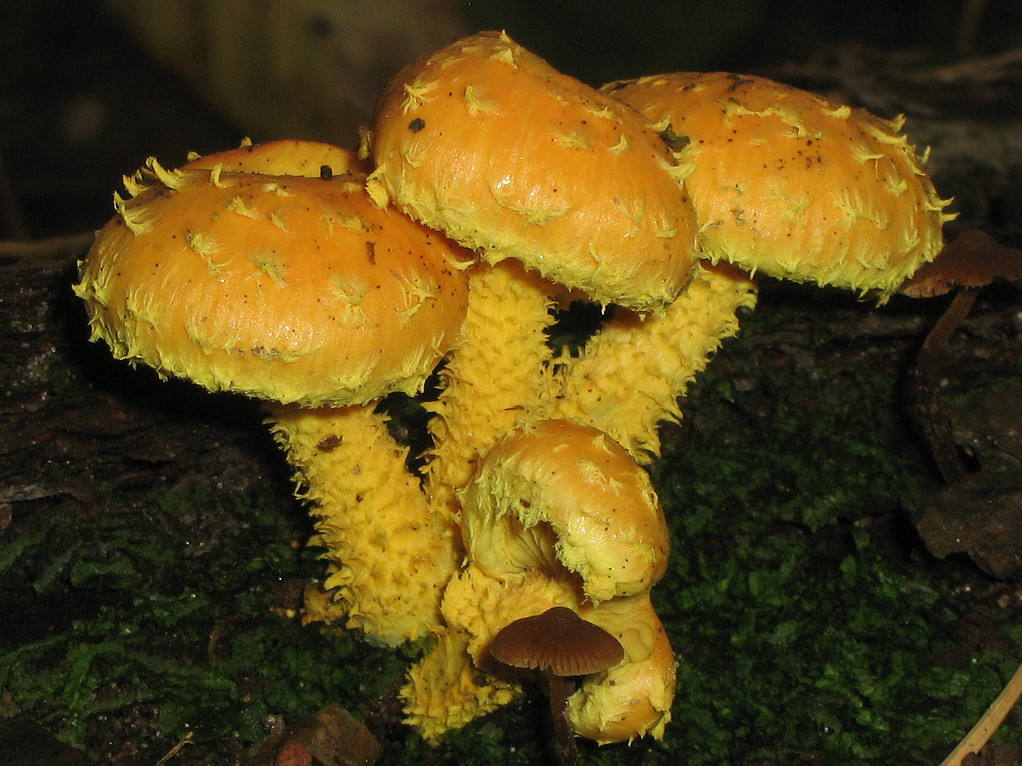
The spikes on yellow pholiotas aren’t actually sharp, but look intimidating nonetheless.
©Anatoliy Vasilchenco (Wild_Cat) / CC BY-SA 3.0 – License
Pholiota flammans
This mushroom is relatively easy to identify, with sharp-looking triangular spikes covering its cap and stem. On the cap, these spiky scales even occur in concentric circles on the convex surface. Yellow pholiotas are also called the “flaming scalycap.” They prefer to grow on dead and rotting wood, ideally conifer.
Yellow pholiota mushroom’s golden-yellow cap and stem range in commonality depending on their location. Clusters of the bright fungus pop up throughout Europe, North America, and Asia. Despite its striking appearance, this mushroom possesses no distinct smell and its edibility is questioned. Some researchers regard it as inedible but nonpoisonous, while some consider it edible but bitter to taste.
The photo featured at the top of this post is © Jaroslav Machacek/Shutterstock.com
The information presented on or through the Website is made available solely for general informational purposes. We do not warrant the accuracy, completeness, or usefulness of this information. Any reliance you place on such information is strictly at your own risk. We disclaim all liability and responsibility arising from any reliance placed on such materials by you or any other visitor to the Website, or by anyone who may be informed of any of its contents. None of the statements or claims on the Website should be taken as medical advice, health advice, or as confirmation that a plant, fungus, or other item is safe for consumption or will provide any health benefits. Anyone considering the health benefits of particular plant, fungus, or other item should first consult with a doctor or other medical professional. The statements made within this Website have not been evaluated by the Food and Drug Administration. These statements are not intended to diagnose, treat, cure or prevent any disease.
Thank you for reading! Have some feedback for us? Contact the AZ Animals editorial team.



